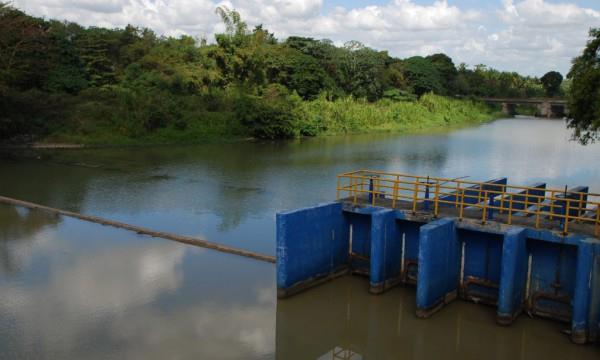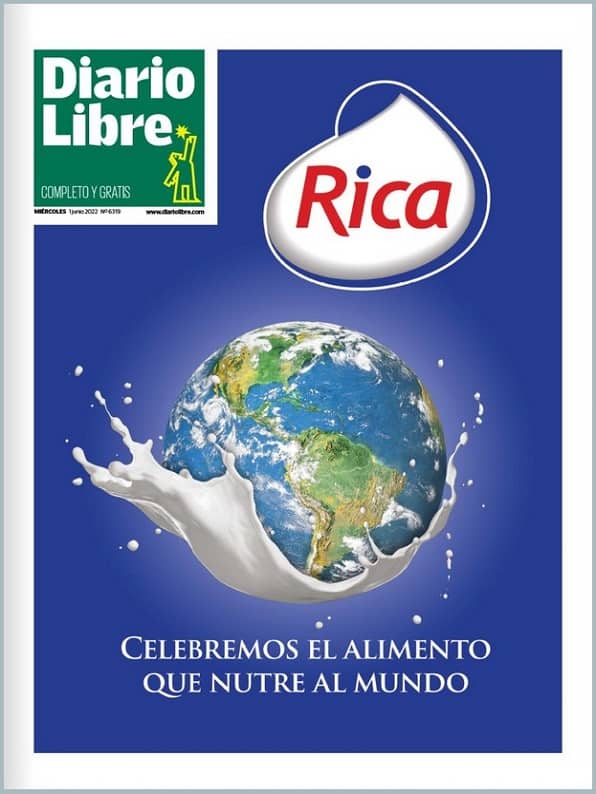Water from CAASD treatment plants is contaminated
In 2013, the CAASD spent RD$2. 2 billion on water purification

SD. An analysis of the water, carried out directly in three of the four treatment plants that the government uses to purify the water sent to more than two million residents of the National District and the province of Santo Domingo showed worrisome results of contamination. On several occasions there has been talk of the low quality with which the water reaches the homes. Many attributed this to cracks in the pipes, but they never made mention of the water being treated in their treatment facilities.
In the samples there was a presence of total coli forms (fecal material), streptococci, pseudomonas, cytrobacter freundi, and enterobacter spp, all bacteria capable of causing gastro-intestinal illnesses, diarrheas, conjunctivitis, otitis, tonsillitis, dental abscesses, meningitis in newborns, and problems during pregnancy in the woman, caused by genital-urinary diseases.
Some of these bacteria, such as streptococci, can also cause complicated diseases of the skin, such as the case of "piodermatitis, which is an infection which if not treated can harm the heart and kidneys," according to the dermatologist Sonica Then.
These are diseases and illnesses that, according to the expert, can also end in lesions and generate severe necrosis.
In the Haina-Manoguayabo treatment plant, located in West Santo Domingo, the sample was taken in the pumping station; in La Isabela, where deterioration was noted, the sample was taken from a spigot that the Santo Domingo Water and Sewer Corporation (CAASD) has for this purpose; while in Valdesia, it was obtained at the chlorine dosification point. The latter sample gave evidence of total coliforms, but in very small volume (10?2), which is worrisome since in order to be drinkable should be zero. All the samples were taken in the presence and with the permission of government authorities.
In a first visit by the Diario Libre to the Haina-Manoguayabo treatment plant, a sample was taken from the washbasin in the bathroom, which was as dirty as the source of the water: the River Haina,
"In this sample we found fungi, yeast, total coliforms that are indicators of fecal contamination, bacilli, streptococci, pseudomonas, proteus, cytrobacter, and klebsiella," said Dr. Frank Reyes, from the Franja Laboratories, where all of the tests on the water were carried out. This laboratory, certified by ISO9002, is based on the Israeli, European and American norms, and uses Israeli technology, since it is a representative of HyLaboratories of Israel.
But the most alarming thing is that just in this treatment plant, they produce 90 million gallons of water a day, which are sent to areas as important as the university, which is frequented by thousands of students each day, and not counting the people who reside in the area. In order to have an idea, the student population just in the Autonomous University of Santo Domingo, to date, is 171,705 students, of which 94,964 go at least once a week to the central campus, located in this area of Santo Domingo.
Here, the same day that the treatment plant in question was visited, a sample was taken of the water sent to this sector. A sealed container was used and the water was taken before it reached the cistern, in order to insure that it was free of contamination from storage. The results show a high degree of contamination which coincides with the bacteria found in the samples taken at the plant that day.
What could be happening?
The president of the Dominican Association of Sanitary and Environmental Engineering (ADIS), Octavio Fernandez, surprised at the results, attributed this to possible problems in the treatment plant.
It is strange and worrisome, because there at any point, the water should be purer than anything, and if it comes from there contaminated, there should be a big problem in the treatment plant," the expert in this area said.
But Dr. Frank Reyes, from Franja Laboratories, attributes this to the fact that in the treatment plants the chlorination process in minimal.
In the meantime, the deputy director for Operations at CAASD, Luis Salcedo, argues that the place where the sample was taken was not the correct one. This is why he accepted a second visit to take a sample of the water.
Upon arrival, the deputy director of Operations of the CAASD, took us to the same building where the first sample was obtained, in order to take the new sample, but in the washbasin of the laboratory, which on this day even had the air conditioning turned on.
However, even though it was not on his agenda to supply water from the pumping station, which is what is received by the people, we asked permission to take a sample from there, too. The results have already been cited.
Incoherencies that leave doubts
It is noteworthy that the water from the washbasin where the sample was taken the first day and that taken from the sink, the second day, were in the same building. Upon questioning Engineer Salcedo, regarding whether this was the same water, he answered "no". Not very clear, given his answer, we kept on questioning:
Q. How many networks do you have in one building?
A. But let me tell you, it is the same water, but listen, with this criteria, It is standing water, and can deteriorate in purity.
Q. But it is the same pipes?
A. The pipes of the laboratory do not have that water, it comes from the pumping station-an idea that is commented out loud by one of the employees-and that Engineer Salcedo takes and continues on with the explanation: Because we use this spigot to take samples for analyzing in the laboratory, it is connected to the pumping station, which you measured at the spigot of the laboratory, and that you took here (he refers to the sample taken at the pumping station) they should have the same characteristics, this is the same water, he emphasizes.
But it turns out that they apparently are not the same, since the level of chlorine from the pumping station was less than that of the sink in the laboratory, and as was mentioned previously, the first showed the presence of contamination.
Separately, Engineer Fausto Doñe was consulted. He is the manager for water treatment and water quality at the Haina-Manoguayabo plant, and we expressed the same worry.
Q. If you were to take us to obtain a sample of water at the Haina-Manoguayabo plant, where would you take us?
A. To the pipe that leave the plant. Just after the pumping equipment.
Q. Where does the water that goes to the laboratory come from?
A. This goes to a cistern that they have up there, an elevated tank like a water tank, and from there by gravity they get it.
Q. Then, it is not a trustworthy point to take a sample from the spigot in the laboratory?
A. No, because this water is internal, we do not use this for the laboratory, and even, the water with which we wash the instruments from there is distilled water that we bring in, because that part is still not disinfected. We disinfect it as it leaves.
In the samples there was a presence of total coli forms (fecal material), streptococci, pseudomonas, cytrobacter freundi, and enterobacter spp, all bacteria capable of causing gastro-intestinal illnesses, diarrheas, conjunctivitis, otitis, tonsillitis, dental abscesses, meningitis in newborns, and problems during pregnancy in the woman, caused by genital-urinary diseases.
Some of these bacteria, such as streptococci, can also cause complicated diseases of the skin, such as the case of "piodermatitis, which is an infection which if not treated can harm the heart and kidneys," according to the dermatologist Sonica Then.
These are diseases and illnesses that, according to the expert, can also end in lesions and generate severe necrosis.
In the Haina-Manoguayabo treatment plant, located in West Santo Domingo, the sample was taken in the pumping station; in La Isabela, where deterioration was noted, the sample was taken from a spigot that the Santo Domingo Water and Sewer Corporation (CAASD) has for this purpose; while in Valdesia, it was obtained at the chlorine dosification point. The latter sample gave evidence of total coliforms, but in very small volume (10?2), which is worrisome since in order to be drinkable should be zero. All the samples were taken in the presence and with the permission of government authorities.
In a first visit by the Diario Libre to the Haina-Manoguayabo treatment plant, a sample was taken from the washbasin in the bathroom, which was as dirty as the source of the water: the River Haina,
"In this sample we found fungi, yeast, total coliforms that are indicators of fecal contamination, bacilli, streptococci, pseudomonas, proteus, cytrobacter, and klebsiella," said Dr. Frank Reyes, from the Franja Laboratories, where all of the tests on the water were carried out. This laboratory, certified by ISO9002, is based on the Israeli, European and American norms, and uses Israeli technology, since it is a representative of HyLaboratories of Israel.
But the most alarming thing is that just in this treatment plant, they produce 90 million gallons of water a day, which are sent to areas as important as the university, which is frequented by thousands of students each day, and not counting the people who reside in the area. In order to have an idea, the student population just in the Autonomous University of Santo Domingo, to date, is 171,705 students, of which 94,964 go at least once a week to the central campus, located in this area of Santo Domingo.
Here, the same day that the treatment plant in question was visited, a sample was taken of the water sent to this sector. A sealed container was used and the water was taken before it reached the cistern, in order to insure that it was free of contamination from storage. The results show a high degree of contamination which coincides with the bacteria found in the samples taken at the plant that day.
What could be happening?
The president of the Dominican Association of Sanitary and Environmental Engineering (ADIS), Octavio Fernandez, surprised at the results, attributed this to possible problems in the treatment plant.
It is strange and worrisome, because there at any point, the water should be purer than anything, and if it comes from there contaminated, there should be a big problem in the treatment plant," the expert in this area said.
But Dr. Frank Reyes, from Franja Laboratories, attributes this to the fact that in the treatment plants the chlorination process in minimal.
In the meantime, the deputy director for Operations at CAASD, Luis Salcedo, argues that the place where the sample was taken was not the correct one. This is why he accepted a second visit to take a sample of the water.
Upon arrival, the deputy director of Operations of the CAASD, took us to the same building where the first sample was obtained, in order to take the new sample, but in the washbasin of the laboratory, which on this day even had the air conditioning turned on.
However, even though it was not on his agenda to supply water from the pumping station, which is what is received by the people, we asked permission to take a sample from there, too. The results have already been cited.
Incoherencies that leave doubts
It is noteworthy that the water from the washbasin where the sample was taken the first day and that taken from the sink, the second day, were in the same building. Upon questioning Engineer Salcedo, regarding whether this was the same water, he answered "no". Not very clear, given his answer, we kept on questioning:
Q. How many networks do you have in one building?
A. But let me tell you, it is the same water, but listen, with this criteria, It is standing water, and can deteriorate in purity.
Q. But it is the same pipes?
A. The pipes of the laboratory do not have that water, it comes from the pumping station-an idea that is commented out loud by one of the employees-and that Engineer Salcedo takes and continues on with the explanation: Because we use this spigot to take samples for analyzing in the laboratory, it is connected to the pumping station, which you measured at the spigot of the laboratory, and that you took here (he refers to the sample taken at the pumping station) they should have the same characteristics, this is the same water, he emphasizes.
But it turns out that they apparently are not the same, since the level of chlorine from the pumping station was less than that of the sink in the laboratory, and as was mentioned previously, the first showed the presence of contamination.
Separately, Engineer Fausto Doñe was consulted. He is the manager for water treatment and water quality at the Haina-Manoguayabo plant, and we expressed the same worry.
Q. If you were to take us to obtain a sample of water at the Haina-Manoguayabo plant, where would you take us?
A. To the pipe that leave the plant. Just after the pumping equipment.
Q. Where does the water that goes to the laboratory come from?
A. This goes to a cistern that they have up there, an elevated tank like a water tank, and from there by gravity they get it.
Q. Then, it is not a trustworthy point to take a sample from the spigot in the laboratory?
A. No, because this water is internal, we do not use this for the laboratory, and even, the water with which we wash the instruments from there is distilled water that we bring in, because that part is still not disinfected. We disinfect it as it leaves.


 Kirsis Díaz
Kirsis Díaz
 Kirsis Díaz
Kirsis Díaz